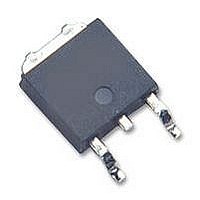LM2940CS-15 National Semiconductor, LM2940CS-15 Datasheet - Page 11

LM2940CS-15
Manufacturer Part Number
LM2940CS-15
Description
Linear Voltage Regulator IC
Manufacturer
National Semiconductor
Specifications of LM2940CS-15
No. Of Pins
3
Output Current
1A
Termination Type
SMD
Mounting Type
Through Hole
Voltage Regulator Type
LDO Linear
Peak Reflow Compatible (260 C)
No
Current Rating
1A
Output Voltage Max
15V
Lead Free Status / RoHS Status
Contains lead / RoHS non-compliant
Available stocks
Company
Part Number
Manufacturer
Quantity
Price
Part Number:
LM2940CS-15/NOPB
Manufacturer:
NS/TI
Quantity:
20 000
Application Hints
an aluminum electrolytic with a solid Tantalum, with the total
capacitance split about 75/25% with the Aluminum being the
larger value.
If two capacitors are paralleled, the effective ESR is the par-
allel of the two individual values. The “flatter” ESR of the Tan-
talum will keep the effective ESR from rising as quickly at low
temperatures.
HEATSINKING
A heatsink may be required depending on the maximum
power dissipation and maximum ambient temperature of the
application. Under all possible operating conditions, the junc-
tion temperature must be within the range specified under
Absolute Maximum Ratings.
To determine if a heatsink is required, the power dissipated
by the regulator, P
The figure below shows the voltages and currents which are
present in the circuit, as well as the formula for calculating
the power dissipated in the regulator:
I
P
The next parameter which must be calculated is the maxi-
mum allowable temperature rise, T
lated by using the formula:
where: T
Using the calculated values for T
mum allowable value for the junction-to-ambient thermal re-
sistance,
IMPORTANT: If the maximum allowable value for
found to be
the TO-263 package, or 174˚C/W for the SOT-223 pack-
age, no heatsink is needed since the package alone will dis-
sipate enough heat to satisfy these requirements.
If the calculated value for
heatsink is required.
HEATSINKING TO-220 PACKAGE PARTS
The TO-220 can be attached to a typical heatsink, or se-
cured to a copper plane on a PC board. If a copper plane is
to be used, the values of
the next section for the TO-263.
IN
D
= I
= (V
L
÷ I
IN
T
A
G
− V
J
FIGURE 2. Power Dissipation Diagram
(max)
(max) is the maximum allowable junction tem-
(J−A)
OUT
53˚C/W for the TO-220 package,
T
) I
, can now be found:
R
L
+ (V
(max) = T
perature, which is 125˚C for commercial
grade parts.
is the maximum ambient temperature
which will be encountered in the applica-
tion.
D
, must be calculated.
(J−A)
IN
) I
G
= T
(J−A)
J
(max) − T
(J−A)
R
(Continued)
(max)/P
will be the same as shown in
falls below these limits, a
R
(max) and P
R
A
(max). This is calcu-
D
(max)
DS008822-37
D
, the maxi-
80˚C/W for
(J−A)
is
11
If a manufactured heatsink is to be selected, the value of
heatsink-to-ambient thermal resistance,
calculated:
Where:
When a value for
a heatsink must be selected that has a value that is less than
or equal to this number.
in the catalog, or shown in a curve that plots temperature rise
vs power dissipation for the heatsink.
HEATSINKING TO-263 AND SOT-223 PACKAGE PARTS
Both the TO-263 (“S”) and SOT-223 (“MP”) packages use a
copper plane on the PCB and the PCB itself as a heatsink.
To optimize the heat sinking ability of the plane and PCB,
solder the tab of the package to the plane.
Figure 3 shows for the TO-263 the measured values of
for different copper area sizes using a typical PCB with 1
ounce copper and no solder mask over the copper area used
for heatsinking.
As shown in the figure, increasing the copper area beyond 1
square inch produces very little improvement. It should also
be observed that the minimum value of
package mounted to a PCB is 32˚C/W.
As a design aid, Figure 4 shows the maximum allowable
power dissipation compared to ambient temperature for the
TO-263 device (assuming
mum junction temperature is 125˚C).
(H−A)
FIGURE 3.
is specified numerically by the heatsink manufacturer
(C−H)
(J−C)
(H−A)
(J−A)
is defined as the thermal resistance from
the junction to the surface of the case. A
value of 3˚C/W can be assumed for
for this calculation.
is defined as the thermal resistance be-
tween the case and the surface of the heat-
sink. The value of
about 1.5˚C/W to about 2.5˚C/W (depend-
ing on method of attachment, insulator,
etc.). If the exact value is unknown, 2˚C/W
should be assumed for
(H−A)
=
TO-263 Package
vs Copper (1 ounce) Area for the
(J−A)
is found using the equation shown,
(J−A)
−
(C−H)
is 35˚C/W and the maxi-
−
(C−H)
(J−A)
(J−C)
(H−A)
DS008822-38
(C−H)
will vary from
for the TO-263
, must first be
.
www.national.com
(J−C)
(J−A)









